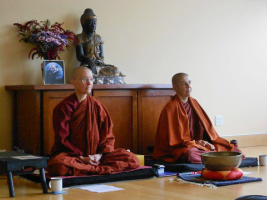Rio Helmi
Délek Dölma left her home in Kham in Tibet's eastern regions at the age of 20. Ordained but illiterate, she yearned to study Buddhism in a more profound way. Délek Wangmo was 16, also ordained, could barely read but was equally determined to deepen her knowledge and understanding of Buddhism. In traditional Tibetan society, when it comes to opportunity to study, nuns are at the bottom end of the priority list. Painfully aware of the fact that in Tibet they hardly stood a chance of studying, much less achieving a scholastic degree, they resolved to escape to India to pursue their dream within the Tibetan community in exile.
They also resolved to generate the "merit" -- which in Buddhist terms refers to the expansive power of the mind generated by virtuous acts -- for this bold undertaking in a uniquely Tibetan way. They journeyed from Lithang to Lhasa by doing full-length prostrations the whole way. To get an idea of what that entails: with your mind focused on the Buddha first you do a full-length prostration flat on the ground, with arms out, then stand up, and then move to the mark where the tips of your fingers touched the ground. And then you start again. Repeat for as many times as it takes to cover 1,475 kilometers. It took them a year and a half.
It would seem the merit they generated helped: once in India they were soon taken under the wing of the Tibetan Nun's Project created by the Tibetan Women's Association to provide education for nuns. By 1993 they were both were inscribed in a long-term study program, the first of its kind. In 2005 the Dolma Ling nunnery, spearheaded by His Holiness the Dalai Lama's sister-in-law Rinchen Khando, opened its doors. To date over 200 nuns have joined the two in this nunnery.
Délek Dölma left her home in Kham in Tibet's eastern regions at the age of 20. Ordained but illiterate, she yearned to study Buddhism in a more profound way. Délek Wangmo was 16, also ordained, could barely read but was equally determined to deepen her knowledge and understanding of Buddhism. In traditional Tibetan society, when it comes to opportunity to study, nuns are at the bottom end of the priority list. Painfully aware of the fact that in Tibet they hardly stood a chance of studying, much less achieving a scholastic degree, they resolved to escape to India to pursue their dream within the Tibetan community in exile.
They also resolved to generate the "merit" -- which in Buddhist terms refers to the expansive power of the mind generated by virtuous acts -- for this bold undertaking in a uniquely Tibetan way. They journeyed from Lithang to Lhasa by doing full-length prostrations the whole way. To get an idea of what that entails: with your mind focused on the Buddha first you do a full-length prostration flat on the ground, with arms out, then stand up, and then move to the mark where the tips of your fingers touched the ground. And then you start again. Repeat for as many times as it takes to cover 1,475 kilometers. It took them a year and a half.
 |
| A philosophy class at Dolma Ling nunnery, via Rio Helmi |































